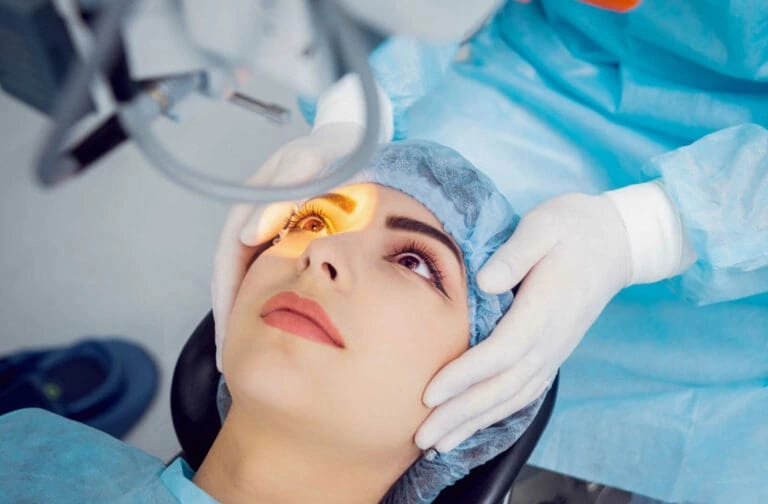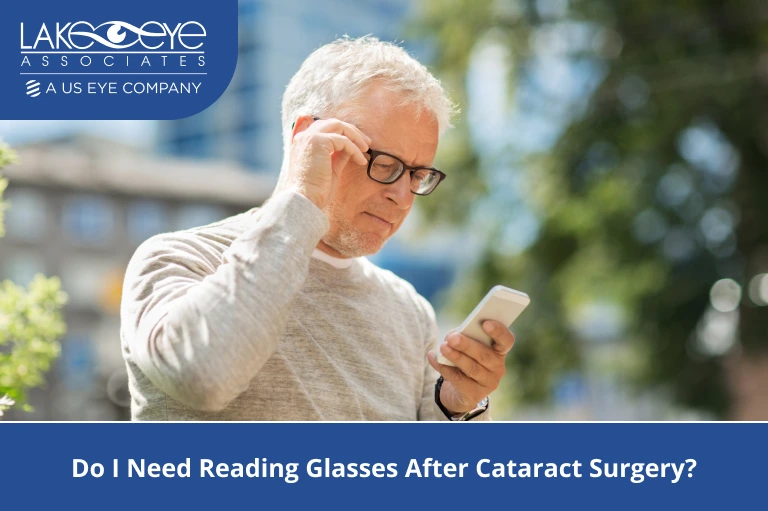Reviewed By: Scott R. Wehrly, MD
Cataract surgery is a highly successful procedure that can result in significant visual improvements. Depending on your overall eye health and vision, as well as the type of lens chosen for implantation, you may need to wear reading glasses for clear, close-up vision after surgery.
Aligning with our patient-first philosophy, your doctor will accurately assess your eyes to advise and educate you on your options. If it’s right for your treatment plan, we may recommend advanced intraocular lenses (IOLs) that provide clear vision at all distances and can eliminate the need for glasses on a day-to-day basis.
Discover the precision of cataract surgery by scheduling an appointment at one of our many locations in Central Florida.
What Is a Cataract?
A cataract occurs when your eye’s natural, clear lens becomes cloudy. With age, the lens in your eye can lose its flexibility and become less transparent. Proteins and fibers begin to break down and clump together, causing the cloudiness.
Your eye’s lens is responsible for bending and focusing light to produce a clear image. When the lens becomes cloudy, it can become increasingly difficult to read, drive, or see objects with definition. Other symptoms of cataracts can include:
- Difficulty seeing at night
- Colors appearing faded or yellow
- Seeing “halos” around lights
- Blurred vision
- Frequent prescription changes
If cataracts impact your day-to-day life or make it difficult for your optometrist to examine the back of your eye, they may recommend cataract surgery. Cataract surgery replaces your natural lens with an artificial lens implant, also known as an intraocular lens (IOL).
The Cataract Surgery Process
Prior to Surgery
Your doctor will perform an ultrasound to measure the size and shape of your eye to determine what type of artificial lens implant you’ll need. There are a variety of IOLs available to help meet your vision needs.
Your doctor will discuss the benefits of each lens and recommend the right IOL for you and your eyes, including whether reading glasses for cataracts might be necessary. Our goal is to provide you with a clear, comfortable vision.
During the Procedure

Your surgeon will either perform your cataract surgery manually or laser-assisted, depending on what is right for you.
For traditional cataract surgery, your surgeon will manually make a small incision in your cornea in order to insert an instrument to break up the clouded lens. This instrument uses ultrasound waves to break up the lens, which is then suctioned out, making room for the artificial lens to be implanted.
Laser-assisted cataract surgery uses innovative technology for advanced precision and improved consistency. This technology maps the unique surface of your eye and programs the exact size, depth, and location for the laser to make the incision. Ultrasound is then used to break up the clouded cataract to be removed, and the new IOL will be implanted.
Laser-assisted cataract surgery can also correct astigmatism if needed. The laser is used to reshape the cornea, helping to give the patient clear vision at all distances.
After Treatment
You can begin to notice improvements in your vision within a couple of days after surgery. It’s normal if your vision appears blurry at first as your eyes adjust and heal. Color will also appear brighter after a cataract is removed.
Follow-up appointments will be scheduled with your eye doctor to monitor healing and the improvement of your vision.
Will You Need Reading Glasses After Cataract Surgery?
There are many factors that your doctor will assess when determining a treatment plan and type of IOL right for you. These factors include overall eye health, the presence of astigmatism, current prescription, and visual needs.
Once your eyes are evaluated, you’ll discuss your options with your doctor. Choosing the right IOL is essential, as it will directly influence your post-surgery vision and whether you’ll need glasses for specific tasks. Different types of IOLs can help treat refractive errors, along with removing and replacing the clouded natural lens. Common types of IOLs include:
1. Fixed-Focus Monofocal Lenses
This is the most common type of lens used in cataract surgery because it offers excellent distance vision. However, since it has a single-strength prescription, most patients will still need reading glasses for close-up tasks such as reading or stitching. Monofocal lenses are the most cost-effective option and have a high success rate, with over 95% of patients reporting improved vision for distance-related activities.
2. Accommodating-Focus Monofocal Lenses
Unlike traditional monofocal lenses, accommodating monofocal lenses can adjust to focus on objects at varying distances. These lenses respond to muscle movements in the eye, mimicking the focusing ability of a natural lens. This means you can perform tasks like reading and watching TV with less need for glasses. According to studies, up to 60% of patients using accommodating lenses can manage most activities without glasses.
3. Multifocal Lenses
Multifocal IOLs are designed to reduce your dependence on glasses by having multiple focusing zones for different ranges. These lenses work similarly to bifocal or progressive eyeglass lenses, allowing for clear visibility at near, middle, and long distances. A clinical study by the American Society of Cataract and Refractive Surgery (ASCRS) found that about 88% of multifocal lens recipients remain glasses-free for most tasks. However, slight glare or halos around lights may occur for some patients after surgery.
4. Toric Lenses
Toric IOLs are specifically designed to correct astigmatism, a refractive error that causes blurred vision at various distances. These lenses offer excellent clarity by addressing the asymmetry in the cornea’s shape. With toric lenses, patients often experience an 80%-90% reduction in cylinder power, helping them achieve improved distance and near vision with minimal need for additional correction.
5. Extended Depth of Focus (EDOF) Lenses
These lenses provide a continuous range of focus, allowing for improved intermediate and distant vision. EDOF lenses are an excellent option for tasks such as working on a computer and driving. Patients often find that EDOF IOLs significantly reduce their need for glasses for intermediate tasks. Additionally, studies from Clinical Ophthalmology indicate that about 77% of patients achieve near-perfect intermediate vision with these lenses.
6. Light-Adjustable Lenses (LAL)
The light-adjustable lens is an innovative option that allows for post-surgery customization. You can adjust the lens’s focus using light treatments after implantation to ensure optimal visual clarity. This tailored approach ensures that up to 92% of patients achieve 20/20 vision for distance or near tasks after adjustments, as reported by the Journal of Cataract & Refractive Surgery.
7. Accommodative Lenses
Accommodative lenses mimic a natural crystalline lens by shifting focus between near and distant objects. These lenses dynamically respond to eye movements, providing rounded vision capabilities. Research by the National Library of Medicine shows that accommodative lenses can help over 70% of patients achieve effective distance and near vision without glasses.
By combining advanced IOL technology with cataract surgery, many patients experience significant improvements in their vision and can often live a life free from glasses. For tailored guidance, always consult your doctor to understand which lens type is ideal for your eye health and lifestyle.
Combining cataract surgery with advanced IOLs can allow you to see clearly at all distances. This technological progress has led to a steady decline in the need for reading glasses post-surgery. Statistics show that premium IOLs have reduced patients’ dependency on corrective eyewear by up to 85%.
Visit American Academy of Ophthalmology to explore more details about cataract surgery and IOL advancements.
Enjoy a Life Free from Frames
The likelihood that you’ll need reading glasses after cataract surgery will depend on your specific treatment plan. Laser cataract surgery is a precise and customizable treatment that can not only replace your clouded lens, it can correct refractive errors such as presbyopia and astigmatism as well.
Discover how cataract surgery can help you achieve brighter, clearer vision today. Surgery is available at our offices in Wildwood, The Villages, Lady Lake, Tavares, and Leesburg. Schedule your appointment today at the location nearest you!






